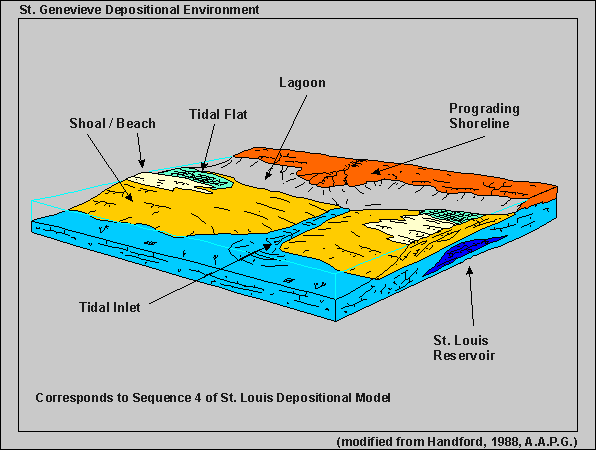Basin: Anadarko
County: Grant and Stanton counties
|
| ||
|
|
Play: St. Louis
(Lower Mississippian) Basin: Anadarko County: Grant and Stanton counties Big Bow Field--Lithofacies--15-187-20437 |
|
This lithofacies ranges from 7 to 10 ft thick in Big Bow Field and consists of silty and shaly, fossiliferous limestones interbedded with thin shales (Closeup Photo 58 & Closeup Photo 59 & Thin Section C). It contains abundant and only slightly abraded fragments to nearly whole echinoderm, brachiopod, and bryozoan skeletal grains. Their presence in a micrite-supported shaly rock suggests open but quiet marine conditions. Shaliness of the lithofacies also points toward a quiet, muddy shelf. Lithofacies 1 has a relatively sharp basal contact in the Plummer core (Core Photo 61/67) with the underlying ooid grainstones of Lithofacies 2, and a thin conglomerate of reworked ooid grainstone also marks the basal contact. This contact may represent a subaerial unconformity or a submarine hardground. The gradual increase in shale upward through the unit indicates either a deepening- or shallowing-upward history. Lithofacies 1 is unconformably overlain by Lithofacies 3.
Mississippian reservoirs produce from ooid-skeletal grainstones in southwestern Kansas. This lithofacies is about 15 to 20 ft thick in most producing fields. One can easily recognize the lithofacies in cores because of its oolitic and coarse-grained fossil content (Closeup Photo 77), its large primary interparticle pores, and dark yellowish brown oil stain. Porous ooid-skeletal gainstones are also easily recognized by the electric-log signatures, because the resistivity, sonic, and density curves faithfully record this facies' interconnected porosity (Thin Section B). Porosity ranges from 10 to 15 percent, and permeabilities commonly reach 100 md.
Ooids are fine- to medium-grained and well sorted. They have radial-concentric cortices surrounding echinoderm, bryozoan, and peloid nuclei. Intermixed skeletal components include crinoids, bryozoans, brachiopods, and foraminifers. Crinoids are almost as abundant as the ooids in some parts of the lithofacies (Closeup Photo 80.5). Most are medium-grained, but some reach very coarse and granule size. As skeletal content increases, overall sorting decreases. Skeletal grains range from nearly whole and barely abraded to broken, well-worn particles. Largest skeletal grains are up to 9.6 mm in diameter. Quartz sand is rarely present.
Cross-bedding is present but does not dominate the lithofacies. Cross sets are less than 1 ft m thick, and foreset laminae have dips of approximately 10'. The laminae are made up of alternating ooid-rich and skeletal-rich layers.
Characteristics of Lithofacies 2 indicate deposition in shallow-marine shoals, perhaps similar to Bahamian marine sand-belts (Ball, 1967; Handford, 1988). The presence of skeletal grains in these oolitic limestones indicates that open-shelf fauna either inhabited portions of the shoal or that the shoal was juxtaposed to an open shelf so that sediment mixing could occur, most likely during storms.
This lithofacies forms stacked eolianite units averaging about 10 ft thick in Big Bow Field, with each unit representing the depositional remains of migrating eolian dune bodies. Interdune-wadi deposits, approximately 4.5 ft thick, of Lithofacies 4 separate each of the eolianite units.
The coastal carbonate eolianites contain approximately 15 to 20 percent siliciclastic sand, with the balance made up of peloids, ooids, and skeletal grains (Closeup Photo 89). Dominant skeletal gains include echinoderrns, brachiopods, bryozoans, and foraminifers. All of the skeletal grains are very well rounded and spherical; even the normally platy or bladed brachiopods and bryozoans have been worn into spherical grains. Furthermore, some ooid coatings are partially worn.
In contrast to the marine-shoal grainstones, all of the ooids and skeletal particles in the eolianite lithofacies are fine to medium grained. Peloids, however, average 0.09 mm (very fine gain size). Thus, the carbonate fraction commonly has a bimodal size distribution. This is also true of the quartz fraction, which comprises two populations: subangular coarse silt and well-rounded coarse sand (Thin Section A). Both populations are either scattered throughout the lithofacies or they are present as discrete sedimentary laminae and insoluble concentrations along stylolites.
The eolianite lithofacies contains both well sorted and bimodal grain populations, of fine to medium sand; whereas, the marine shoal lithofacies is made up of moderately to poorly sorted, medium to very coarse grained particles. These textural differences reflect the change from subaqueous to eolian physical processes of sedimentation present in marine to eolian environments.
The eolianite lithofacies is almost pervasively cross-bedded. This is in contrast to the marine gainstone lithofacies, which is both cross-bedded and bioturbated. Eolianite cross-bed sets range from less than 1 to 10 ft thick and average approximately 1 to 3 ft. Foreset laminae are inclined about 16' to 20', with dip angles locally increasing from bottom to top in individual sets.
Evidence for subaerial weathering is seen in an eolianite, which grades upward into a 3 ft thick breccia of eolianite (Core Photo 80/85) Clasts are poorly sorted, angular to rounded, and range from approximately 1 to 6 inches in diameter. Despite some rounding of clasts, this breccia shows no evidence of sediment transport, because some appear to be fitted, and they are barely separated from one another by a matrix of eolianite sand. A carbonate mudstone is the prevalent matrix at the top of the breccia. The clasts formed as a result of subaerial weathering (disaggregation) of a surface and near-surface crust of weakly cemented eolianite. The grainy sediment between clasts was deposited as loose dune sand, and the carbonate mud probably represents pond and/or initial marine sediment filtered in from above during a subsequent transgression.

Handford, C.R. and Francka, B. J., 1991, Mississippian Carbonate-Siliclastic Eolianites in Southwestern Kansas: SEPM Core Workshop No. 15, p. 205-244.